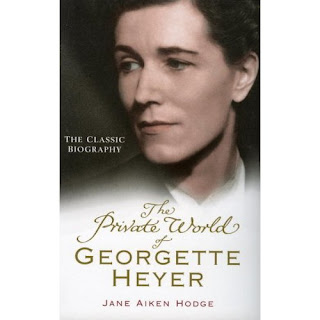
Winner of a signed copy of The Wild Marquis is…..
Daphne!!
Email us at riskies@yahoo.com with your snail mail address!

Winner of a signed copy of The Wild Marquis is…..
Daphne!!
Email us at riskies@yahoo.com with your snail mail address!
This week we start our discussion of Georgette Heyer’s Venetia, led by Carolyn. I’ve already read the first seven chapters and then some.

Georgette Heyer, 1902-1974, is credited with creating the Regency Romance, even now the most popular historical romance genre. Heyer’s first book came about when she was 19. She created The Black Moth, a Georgian story, as a way to entertain an ill brother. It was the start of a wonderful career of writing both Georgian/Regency novels and mysteries.
Heyer tended to depreciate the importance of her works. She wrote of one of her books to her editors:
“I think myself I ought to be shot for writing such nonsense, but it’s questionably good escapist literature and I think I should rather like it if I were sitting in an air-raid shelter, or recovering from flu. Its period detail is good; my husband says it’s witty—and without going to these lengths, I will say that it is very good fun.”
Reviewers also did not take her work seriously, dismissing her books as “froth.”
Still, Heyer was very serious about crafting her works. Her historical novels were based on impeccable research and her interpretation of the Regency world has formed the basis of the traditional regency genre (in my opinion), even though we now know Heyer did not always get it right and, to ferret out plagiarists, she is known to have inserted historical facts of her own creation.
Heyer was married to a mining engineer turned barrister. She had one son (who became a judge). She was an intensely private person. No book tours and publicity appearances for her.
The Private World of Georgette Heyer by Jane Aiken Hodge is a lovely biography of Heyer’s life. You can read her introduction here.
One of the vignettes Hodge writes of was how carefully Heyer researched the battle of Waterloo for An Infamous Army, claiming, for instance, that all of Wellington’s dialogue in the book was actually spoken or written by him. Around the time Heyer wrote An Infamous Army, she took her young son to the National Army Museum in Chelsea where Siborne diorama of the Waterloo battle is displayed. As she stood there explaining the battle to her son, a crowd gathered to listen, amazed that this mere woman spoke so knowledgeably. Little did they know they were in the presence of greatness!
In my 2005 trip to London we visited the National Army Museum. As I examined the diorama, I thought of Heyer explaining the battle to her son. The difference was, I knew I was standing where a great woman had stood.
I cannot wait to begin our discussion of Venetia!!! Be sure to join us for it!
What do you know of Georgette Heyer’s life? If you could, what would you like to ask her?
 The Riskies welcome back Miranda Neville who is bringing with her The Wild Marquis, her second Regency Historical from Avon. The Wild Marquis is the first book in her Burgundy Club Series. Remember when Miranda brought us the Regency culinary world in href=”http://www.mirandaneville.com/books.php”>Never Resist Temptation? Wait until you see what she has in store for us this time!
The Riskies welcome back Miranda Neville who is bringing with her The Wild Marquis, her second Regency Historical from Avon. The Wild Marquis is the first book in her Burgundy Club Series. Remember when Miranda brought us the Regency culinary world in href=”http://www.mirandaneville.com/books.php”>Never Resist Temptation? Wait until you see what she has in store for us this time!
Neville brings on the sizzle along with an intriguing and unique Regency backdrop — a nobleman’s “addiction” to rare book collecting — in the well-crafted start to the Burgundy series.–RT Book Reviews
Mirana will give away a signed copy of The Wild Marquis to one lucky commenter chosen at random.
Welcome back, Miranda! Tell us about The Wild Marquis.
The Marquis of Chase (known as Cain) is, I think, a delectable hero. He’s a rake with a dark past, but also a lot of fun. He never feels sorry for himself and he loves women, not just as lovers but also as friends. When he finally falls in love, as he does with Juliana, a short and rather grumpy tradeswoman who is mainly interested in her struggling rare book business, he falls hard.
I’ll admit that “rake” is short hand for a hot Regency guy who has had a lot of girlfriends. I’d find it hard to rehabilitate a hardened womanizer, not to mention the hovering threat of venereal disease. Cain isn’t like that and the catalyst for the story is his desire to restore his reputation by buying back a rare medieval manuscript sold by his father. It turns out that Juliana, whose husband was murdered, is in danger. The secrets of both characters’ pasts are entangled in the intrigues of a pair of rival bibliophiles.
The Wild Marquis is your second book, and second books pose their own unique anxieties and challenges. Did you experience “Second Book Syndrome?” What were the unique challenges of writing a second book?
I find this question extremely frightening. I thought “Second Book Syndrome” was when your sophomore effort sucks, disappears in the bookstore, and your career dies on the vine. I am burning logloads of incense to the Bookscan Gods to avert this fate.
Perhaps I’ll avoid it because The Wild Marquis isn’t my second book. Avon refused to buy the sequel to Never Resist Temptation on the grounds that it was about opera and wouldn’t sell. I actually found The Wild Marquis relatively easy to write and the next one, which I just finished, easier still. No, what am I saying? It’s never easy. But with each book I gain confidence in my ability to recognize what works and what doesn’t. Grinding out 90,000 words is as hard as ever and I’m not sure how it ever happens. As the theater manager says in Shakespeare in Love, “it’s a mystery.”
In Never Resist Temptation you brought us a heroine who is an accomplished chef, showing us a glimpse of the Regency’s culinary world and sharing some of your research on Prinny’s chef Carême. What fascinating research did you find in writing The Wild Marquis?
Continuing the theme of heroines with jobs, Juliana owns a rare book shop. The background to the story is the sale of a huge book collection at Sotheby’s. I based it on the sale of the Duke of Roxburghe’s library, the most famous book auction of the nineteenth century. Having worked in Sotheby’s rare books department for several years. I had a good grounding in the basics, but I researched the Regency era book trade. Collecting tastes change over time and I had to make sure the things my characters collected were period appropriate.
A quarto edition of Romeo and Juliet plays an important part in the plot. Had my book been set a hundred years earlier I couldn’t have done that, because it wasn’t fashionable to collect Shakespeare. For my own convenience I have my heroine talk about “good” and “bad” Shakespeare quartos, a distinction that wasn’t made until the early twentieth century. I reasoned (?rationalized) that she could have been brilliantly ahead of her time in judging the bard’s texts.
What is risky about The Wild Marquis?
I’d have to say the setting. I’m crossing my fingers that readers don’t find the whole notion of rare book collecting hopelessly dry and geeky.
What is next for you?
At the end of The Wild Marquis, a group of young men form The Burgundy Club, a society of bibliophiles. The president of the club is Sebastian Iverley, a bespectacled misogynist. When he vetoes the admission of women Juliana, my heroine, swears revenge. In The Dangerous Viscount, coming in October, she gets to see Sebastian fall in love and have a very hard time of it. Avon recently accepted my proposal for two further books in the same series.
In historical romance we see more heroines with jobs these days. I’ve written a pastry cook and now a bookseller. The heroines of my next two books are more conventional: a well born lady of leisure and a governess, respectively. As writers and/or readers do you prefer more independent women, or are you happy to stick with tradition? One commenter will win a signed copy of The Wild Marquis.
